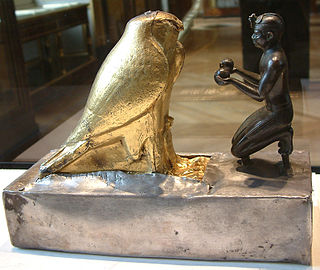
In Egyptian mythology, Hemen was a falcon–god.

Menes was a pharaoh of the Early Dynastic Period of ancient Egypt credited by classical tradition with having united Upper and Lower Egypt and as the founder of the First Dynasty.
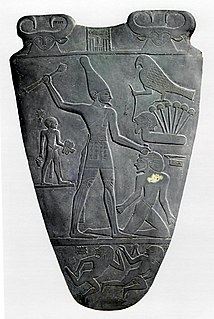
Narmer was an ancient Egyptian pharaoh of the Early Dynastic Period. He was the successor to the Protodynastic king Ka. Some consider him the unifier of Egypt and founder of the First Dynasty, and in turn the first king of a unified Egypt. A majority of Egyptologists believe that Narmer was the same person as Menes.
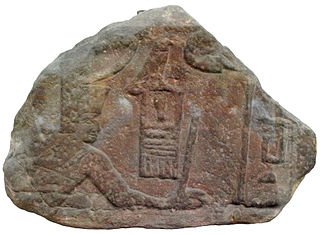
Sanakht is the Horus name of an ancient Egyptian king (pharaoh) of the Third Dynasty during the Old Kingdom. His chronological position is highly uncertain, and it is also unclear under which Hellenized name the ancient historian Manetho could have listed him. Many Egyptologists connect Sanakht with the Ramesside cartouche name Nebka. However, this remains disputed because no further royal title of that king has ever been found; either in contemporary source or later ones. There are two relief fragments depicting Sanakht originally from the Wadi Maghareh on the Sinai Peninsula.

Usermaatre Setepenre Meryamun Ramesses VII was the sixth pharaoh of the 20th Dynasty of Ancient Egypt. He reigned from about 1136 to 1129 BC and was the son of Ramesses VI. Other dates for his reign are 1138–1131 BC. The Turin Accounting Papyrus 1907+1908 is dated to Year 7 III Shemu day 26 of his reign and has been reconstructed to show that 11 full years passed from Year 5 of Ramesses VI to Year 7 of his reign.

Djer is considered the third pharaoh of the First Dynasty of ancient Egypt in current Egyptology. He lived around the mid-thirty-first century BC and reigned for c. 40 years. A mummified forearm of Djer or his wife was discovered by Flinders Petrie, but was discarded by Émile Brugsch.

Hor-Aha is considered the second pharaoh of the First Dynasty of Egypt by some Egyptologists, others consider him the first one and corresponding to Menes. He lived around the 31st century BC and is thought to have had a long reign.

Djet, also known as Wadj, Zet, and Uadji, was the fourth pharaoh of the First Dynasty. Djet's Horus name means "Horus Cobra" or "Serpent of Horus".

Umm El Qaʻāb is a necropolis of the Early Dynastic Period kings at Abydos, Egypt. Its modern name means "Mother of Pots" as the whole area is littered with the broken pot shards of offerings made in earlier times. The cultic ancient name of the area was (w-)pkr or (rꜣ-)pkr "District of the pkr[-tree]" or "Opening of the pkr[-tree]", belonging to tꜣ-dsr "the secluded/cleared land" (necropolis) or crk-hh "Binding of Eternity".

Iry-Hor or Ro was a predynastic pharaoh of Upper Egypt during the 32nd century BC. Iry-Hor's existence was debated, with the Egyptologist Toby Wilkinson contesting the reading and signification of his name. However, continuing excavations at Abydos in the 1980s and 1990s and the discovery in 2012 of an inscription of Iry-Hor in the Sinai confirmed his existence. Iry-Hor is the earliest ruler of Egypt known by name and is sometimes cited as the earliest-living historical person known by name.

Hor Awibre was an Egyptian pharaoh of the 13th Dynasty reigning from c. 1777 BC until 1775 BC or for a few months, c. 1760 BC or c. 1732 BC, during the Second Intermediate Period. Hor is known primarily thanks to his nearly intact tomb discovered in 1894 and the rare life-size wooden statue of the king's Ka it housed.
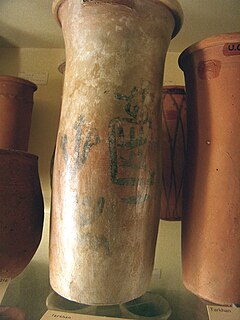
Ka, also (alternatively) Sekhen, was a Predynastic pharaoh of Upper Egypt belonging to Dynasty 0. He probably reigned during the first half of the 32nd century BC. The length of his reign is unknown.

Sekhemrekhutawy Khabaw was an Egyptian pharaoh of the early 13th Dynasty during the Second Intermediate Period. According to the egyptologist Kim Ryholt, he was the sixteenth king of the dynasty, reigning for three years, from 1775 BC until 1772 BC. Thomas Schneider, on the other hand, places his reign from 1752 BC until 1746 BC. Alternatively, Jürgen von Beckerath sees him as the third king of the dynasty. As a ruler of the early 13th Dynasty, Khabaw would have ruled from Memphis to Aswan and possibly over the western Nile Delta.
Wadjkare was an ancient Egyptian pharaoh of the Eighth dynasty who reigned c. 2150 BC during the First Intermediate Period. He is considered to be a very obscure figure in Egyptian history.

Djedkheperew was an Egyptian pharaoh of the 13th Dynasty reigning for an estimated two-year period, from c. 1772 BC until 1770 BC. According to Egyptologists Kim Ryholt and Darrell Baker, Djedkheperew was the 17th king of this dynasty. Djedkheperew is this pharaoh's Horus name; the prenomen and nomen of Djedkheperew, which would normally be employed by modern conventions to name a pharaoh, are unknown.

Iyibkhentre was an ancient Egyptian or Nubian ruler who most likely reigned at the end of the 11th and beginning of the 12th Dynasty.
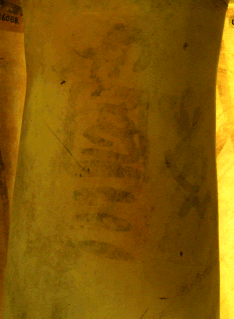
Crocodile is the provisional name of a predynastic ruler, who might have ruled during the late Naqada III epoch. The few alleged ink inscriptions showing his name are drawn very sloppily, and the reading and thus whole existence of king "Crocodile" are highly disputed. His tomb is unknown.
Hedju Hor was a ruler in northern Egypt from the Predynastic Period. His existence is controversial.

Ny-Hor was a possible pharaoh from the Predynastic Period. His name means "The Hunter". He may have ruled during the 31st century BCE.

Hat Hor is a possible pharaoh or king of Dynasty 0. of Predynastic Egypt.

















